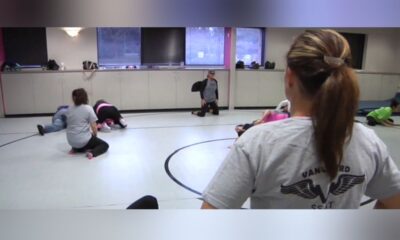There is a place for everyone at Gracie Jiu-Jitsu Pasadena. From 3-year-olds to grandparents, anyone can join and learn self-defense skills while gaining strength and finding community. The gym officially opened on March 15 but will have its grand opening on Saturday, May 4.
The benefits of jiu-jitsu are threefold, explained owner Fred Joaquin. “Because you’re not maybe used to moving your body in these ways, it can be a workout,” he said. It’s a form of exercise, a potentially life-saving skill and a positive social outlet. “Studios become little communities,” and people who join usually come two to three times a week, he said.
Joaquin only started toying with opening a studio last year after practicing jiu-jitsu avidly for the past 12 years. He was drawn to the martial art to “stay in shape and learn self-defense,” he explained. Previously, Joaquin owned an Allstate Insurance Agency in Glendale but realized he could not imagine doing insurance for the rest of his life.
“The only other thing that I loved was jiu-jitsu,” Joaquin said, so opening a gym was an obvious choice.
The gym gives a whole new meaning to the idea of a family-owned business. Joaquin’s wife, Aida, also practices jiu-jitsu and is an instructor for their Women Empowered class. His two oldest children also participate, and he anticipates that one day, the youngest, less than a year old, will join in, too.
Jiu-jitsu is a Japanese martial art, but in 1925, the Gracie family in Brazil adopted it and adapted it to involve more leverage and technique. More broadly, it is known as Brazilian jiu-jitsu.
“There are very few martial arts that are new enough that you could know who started it,” Joaquin said. To use the Gracie name, gyms must be approved by the family.
In the 1970s, two Gracie brothers, Carlos and Rorion, moved to the United States, bringing jiu-jitsu with them. Rorion went on to found the Ultimate Fighting Championship in 1993.
“That’s when people started to realize that there’s something to this jiu-jitsu thing. No fighter would ever dare compete in the UFC without knowing jiu-jitsu,” Joaquin said.
“If you have to end up on the ground and you know jiu-jitsu, you have a huge advantage over even someone much bigger than you who does not know jiu-jitsu,” he continued.
However, unlike other jiu-jitsu schools, which are more focused on tournament-style jiu-jitsu, Joaquin’s studio focuses on practical techniques for self-defense.
“The average person who wants to do jujitsu is not interested in joining tournaments,” Joaquin explained. “We want to be the school where the average person, middle age to older, can learn jiu-jitsu, not have to be competing in class, have a fun time, leave injury-free, learn some legitimate self-defense and get a little healthier. That was where we wanted to make our mark, as an accessible gym that’s open to all ages.”
Students will learn multiple techniques during a one-hour class, some standing, others on the floor. The gym offers four main programs. Women who want to learn self-defense can join the Women Empowered class, an all-women class focusing on practical skills to thwart various attacks.
“There’s no frills or any moves that require athleticism or strength,” Joaquin said.
In the short time the gym has been open, women are already attending the class regularly.
Then, there is a co-ed beginner program, which teaches jiu-jitsu fundamentals geared toward street self-defense. Students don full traditional garb called “gis.” In the beginner program and Women Empowered, there is no sparring, focusing on technique with partners in what Joaquin calls “cooperative resistance,” with gradually added resistance.
“Everything’s very practical, and with step-by-step instructions, you practice in a collaborative environment,” Joaquin said. “The vibe is really good. Everybody’s laughing and smiling, and there’s lots of talking. It’s almost like a social event.”
Gracie Bullyproof is a kids program geared toward children ages three to 16. Not only does the program teach jiu-jitsu, but it also imparts verbal deescalation, negotiation and the five rules of engagement — avoid the fight at all costs; if physically attacked, defend yourself; if verbally attacked, follow the Three T-steps (talk, tell, tackle); never punch or kick the bully — establish control and negotiate; and when applying submissions use minimal force and negotiate. There are also conversations surrounding why someone might turn to bullying.
“The program has a component of using your voice instead of immediately tackling a bully,” Joaquin explained.
The Master Cycle program is for intermediate and advanced practitioners — blue and black belts, unlike the white belt for beginners.
“Besides the basic self-defense, there are tons of cool and fun techniques to learn,” Joaquin said.
The Master Cycle program also includes sparring. In other jiu-jitsu schools, students might begin sparring on the first day of class, but at Gracie Jiu-Jitsu Pasadena, newcomers do not spar for at least six months to focus on fundamentals and technique.
“We have a gradual on-ramp for beginners,” Joaquin said. “If you have a bad first experience at the wrong school, you could easily be deterred from continuing.”
For people interested in learning jiu-jitsu, Joaquin wants people to know “that if they’re interested in learning self-defense and looking for a healthy, fun activity, there is a place for them at Gracie Jiu-Jitsu Pasadena,” he said. “We’re probably the most inclusive and welcoming gym out there in terms of jiu-jitsu. We have showers and amenities. It’s very much a high-end, like the Equinox of jiu-jitsu.”





















